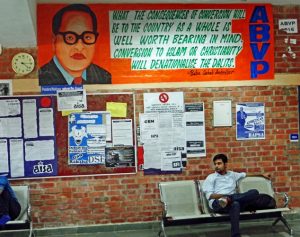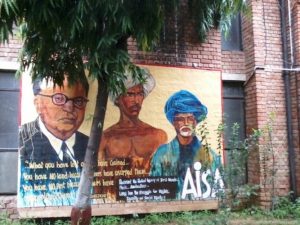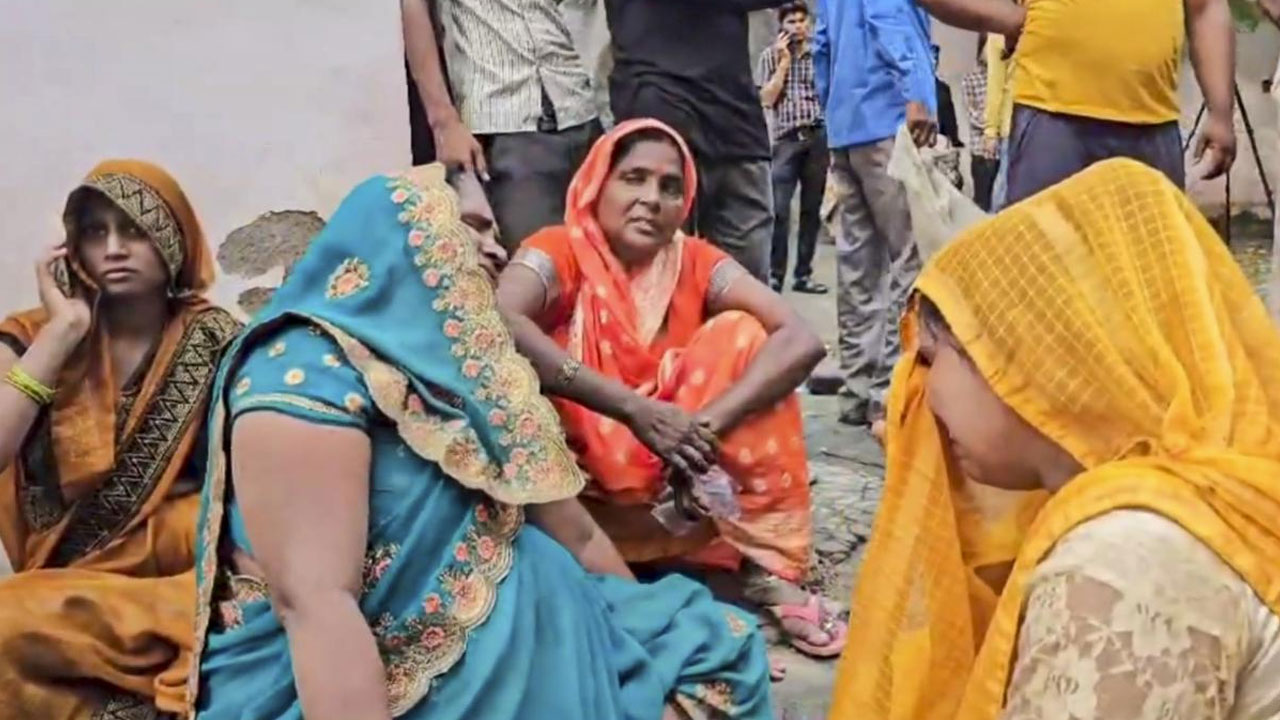 The recent decision of JNU administration to rename its Central Library after Dr B. R. Ambedkar is another attempt by the Hindutva forces to appropriate him. The activists of the ABVP, the students’ group affiliated to the RSS, used the media and other means to draw attention to their “struggle” that resulted in renaming the Central Library. The ABVP claimed that the JNU Executive Council, the highest statutory body, acted on its “demand”. Its media management was successful as several newspapers prominently highlighted its role, quoting the statement of ABVP leader and JNUSU Joint Secretary Saurabh Kumar Sharma.
The recent decision of JNU administration to rename its Central Library after Dr B. R. Ambedkar is another attempt by the Hindutva forces to appropriate him. The activists of the ABVP, the students’ group affiliated to the RSS, used the media and other means to draw attention to their “struggle” that resulted in renaming the Central Library. The ABVP claimed that the JNU Executive Council, the highest statutory body, acted on its “demand”. Its media management was successful as several newspapers prominently highlighted its role, quoting the statement of ABVP leader and JNUSU Joint Secretary Saurabh Kumar Sharma.
Another Hindutva leader Subramanian Swamy, who hardly misses a chance to comment on issues related to JNU, joined ABVP’s celebration. He tweeted to welcome the decision, calling the renaming a “cultural revolution”, unmindful of the fact that it is a term that belongs to the Maoist tradition, which he perhaps dislikes the most.
Apart from installing a statute of Babasaheb in the Central Library, the ABVP has also come out with other demands such as the renaming of the Sports Ground and the Convention Centre after the Adivasi revolutionary Birsa Munda and former president A.P.J. Abdul Kalam, respectively. Needless to say, these are tokenisms aimed at wooing the deprived sections such Dalits, Adivasis and Muslims.
The ABVP activists are hopeful that their “achievement” of having the library renamed will help them woo lower-caste students, particularly Dalits. With the JNUSU elections approaching, the Hindutva organization is desperate to broaden its social base by such acts of appropriation and tokenism.
For a long time, the mainstream political organizations have largely ignored Ambedkar. However, the rise of Ambedkarite social and political movements and the growing consciousness of Dalits made them realize that Ambedkar, the icon, is needed to expand their social base among the marginalized sections. So, they launched into the mission of appropriating Ambedkar. However, such a manoeuvring by the mainstream political organisations, as Dalits contend, has more to do with their own survival than their embracing Ambedkar’s thoughts.
Meanwhile, the social composition of JNU has been changing fast. Inspired by Ambedkarite movements and having benefited from reservations and other state-sponsored welfare programmes, a section of the marginalized communities slowly began to knock at the doors of upper-caste/class-dominated higher education. The implementation of OBC reservation in higher education in 2007 accelerated the process of assertion by Dalitbahujans. This dynamism was seen at least in three spheres: change in social composition, Dalitization of public culture and inclusion of Dalitbahujan agendas.

The shift in the social demography of students is worthy of note. According to the 45th Annual Report (2014-15), out of the 8,308 JNU students, there were 4,278 Dalitbahujan students (1201 SCs + 643 STs + 2443 OBCs). Simply put, the percentage of non-upper-caste students today is roughly around 50 per cent. If other deprived social groups, minorities and women are taken into account, the numerical strength of upper castes and classes gets further reduced.
Against this background, the Left organizations on the campus were perhaps first to change their course. Having ignored Dalitbahujan icons till recently, they modified their language and began to talk of a “unity” between the Left and the Ambedkarites. The Left organizations of JNU were increasingly seen wearing Ambedkar, Periyar, Birsa Munda and Phule on their sleeve. Posters, pamphlets and badges carrying the slogans and images of Dalitbahujan heroes and heroines began to outshine those of Marxist icons such as Marx, Lenin, Trotsky, Stalin and Mao.
Hindu Right’s attempt to appropriate Ambedkar
The Hindutva forces on the campus also felt an urgent need to change its strategy. Since Sandeep Mahapatra’s election to the post of president in 2000-01, the ABVP’s only noteworthy presence in the JNU Students’ Union has been the one seat on the central panel it won last year. One of the possible reasons for ABVP’s electoral failure has to do with its inability to broaden its social base beyond the upper castes, mostly from northern India. The reason for the stagnation of the ABVP in the last decade is its failure in recruiting cadres from outside northern India. Saurabh Kumar Sharma, the JNU ABVP leader, seemed to support this argument when he claimed that JNU ABVP now drew its members from almost all parts of India such as Orissa, Bengal, Assam, Karnataka, Arunachal Pradesh and Assam, which traditionally have not been Hindutva strongholds.
According to observers, ABVP success in extending its reach among non-Hindi speaking groups has been facilitated by its politics of tokenism, symbolism and appropriation of lower-caste icons, particularly Ambedkar. Celebrations of Ambedkar Jayanti (birth anniversary) and Mahaparinirvan Diwas (death anniversary) have been regularly organized by JNU’s ABVP unit for a few years. Even the venue of a recent hunger strike by the JNU ABVP in support of the action taken against “anti-nationals” for the February 9 incident had a portrait of Ambedkar and a “Bharat Mata” poster side by side, with the slogan “Jai Bhim” written on the wall.
Also noteworthy was Hindutva forces’ propaganda to interpret Dr Ambedkar as a “reformer” of Hindu society and staunch “nationalist” who played a key role in drafting the Constitution and “opposed” Muslim “separatism” and “extra-territorial loyalty” of the Communists.
Another master strategy of the ABVP has been to sow seeds of suspicion and hatred against Muslims in the hearts and minds of Dalits. The ABVP has thus been saying that the “decline” of the status of Dalits has to do with the coming of Muslim “invaders”. Such a discourse is to demonize Islam and Christianity as foreign religions. A recent JNU ABVP poster of Ambedkar with a saffron background warns Dalits against embracing Islam as well as Christianity and becoming “denationalized”. The poster quotes Ambedkar as saying: “What the consequences of conversion will be to the country as a whole is well worth bearing in mind. Conversion to Islam or Christianity will denationalize the Dalits.”
Further, ABVP has been saying that Dalits were “staunch Hindus” who were forced to live a degraded life because they opposed the “oppression” of Muslim rulers and “refused” to be converted to Islam. Besides, it has been sensationalizing and deliberately giving a “communal” to any hint of Dalit-Muslim “conflict”. It has been repeatedly highlighting that Aligarh Muslim University and Jamia Millia Islamia, institutions dominated by Muslims, have been denying reservations to SCs.
In order to antagonize Dalits against the Left, the ABVP claims that Ambedkar was “anti-Communists”, conveniently overlooking the fact that his concern for labour was central to his ideas and he worked along with communists. ABVP’s take is that Dr Ambedkar, despite suffering a lot in his life, did not create animosity but rather worked for harmony (samrasta) in society.
 Note that the discourse of the Left about radical transformation of society is presented as an attempt to create disharmony and as a threat to the “unity” of the country. Thus, an ABVP pamphlet, dated 18 January 2016, took a dig at the Communists: “We must understand the hidden agenda of the leftists when they attack the state machinery. This state machinery runs according to the Constitution that was drafted by none other than Babasaheb Bhim Rao Ambedkar himself. We can understand their frustration with this Constitution and state machinery because they are not capable of operating in a transparent manner … It has been the history of Indian communists to radicalize the youth with the various slogans and then turn them against the Indian state and people. We must not forget the shameful origin of the CPI (M), SFI’s parent organization. It was founded by those communist leaders who acted as spies for China during the 1962 War.’
Note that the discourse of the Left about radical transformation of society is presented as an attempt to create disharmony and as a threat to the “unity” of the country. Thus, an ABVP pamphlet, dated 18 January 2016, took a dig at the Communists: “We must understand the hidden agenda of the leftists when they attack the state machinery. This state machinery runs according to the Constitution that was drafted by none other than Babasaheb Bhim Rao Ambedkar himself. We can understand their frustration with this Constitution and state machinery because they are not capable of operating in a transparent manner … It has been the history of Indian communists to radicalize the youth with the various slogans and then turn them against the Indian state and people. We must not forget the shameful origin of the CPI (M), SFI’s parent organization. It was founded by those communist leaders who acted as spies for China during the 1962 War.’
Note that the ABVP attacks the communists by painting itself the “follower” of Babasaheb Ambedkar and his drafted Indian Constitution. However, the same students’ outfit has never questioned its parent party, BJP, for going against Ambedkar’s ideas. Ambedkar stood for liberty, equality and fraternity while the Hindutva forces are protecting Brahmanism and inequality, and encouraging polarization and division among the people.
With these measures, the ABVP has succeeded in bringing a section of lower-caste students into its fold. As a result, the Hindutva organization appears relatively strong at this movement. A considerable section of upper castes that had long expressed its allegiance to “progressive” politics on the campus have made a ghar wapsi (homecoming) to the Hindutva outfit, particularly after its recent ascendancy.
In an interview last year, a well-known face of the JNU unit of the ABVP, too, hinted at this newfound dynamism. Sandip Kumar Singh, a research scholar in international studies and an OBC from Bihar, admitted that a large number of lower-caste students had joined the ABVP. “The Dalits and Backwards dominate ABVP. Today, out of every 10 members of the JNU ABVP unit, eight are OBCs and SCs. The president and general secretary are OBCs from Bihar and Rajasthan,’ added Singh, who contested for the post of JNUSU general secretary in 2012 as an ABVP candidate. But when asked how Dalits and OBCs could ever dominate an organization that has so far not rejected Brahmanism and Manu’s ideology, Singh retorted: “Who is worshipping Manu today? Manu’s ideology is dead. Such issues are raked up by those want to divide Indian society. Unlike the rhetoric of communists, ABVP is not explicitly against Dalits. Rather, we want to build a samras samaj [harmonious society]. But one thing is for sure – that the leadership will remain in the hands of the Dalits and Backwards.”
 Is the leadership from among the Dalits and Backwards? Not quite so. The ABVP is still has an upper-caste leadership at the top. Moreover, a number of lower-caste ABVP members recently abandoned the saffron organisation and burnt the Manusmriti in protest against the institutional murder of Rohith Vemula and the attack on secular and progressive institutions. Against this backdrop, Singh’s claims seemed exaggerated. However, it is true that there is a larger representation of the lower castes on the lower rung of the ABVP.
Is the leadership from among the Dalits and Backwards? Not quite so. The ABVP is still has an upper-caste leadership at the top. Moreover, a number of lower-caste ABVP members recently abandoned the saffron organisation and burnt the Manusmriti in protest against the institutional murder of Rohith Vemula and the attack on secular and progressive institutions. Against this backdrop, Singh’s claims seemed exaggerated. However, it is true that there is a larger representation of the lower castes on the lower rung of the ABVP.
Moreover, the Hindu right has hardly missed an opportunity to widen inter-caste differences within marginalized groups. It has played identity politics in its own way. For example, when it fielded a candidate from a particular caste, it tried to break the opposition camp by appealing to the students to vote along caste lines.
‘Degrading and humiliating’
Having said that, ABVP’s politics of appropriation has been constantly challenged by Ambedkarite politics. Babasaheb Ambedkar’s radical legacy and assertive Ambedkarite movements have been big hurdles in the path of the Hindutva juggernaut.
For example, the United Dalit Students’ Forum (UDSF) easily saw through ABVP’s efforts behind renaming the Central Library. UDSF’s latest pamphlet was titled, “Ambedkar can neither be adopted nor appropriated by Hindutva forces”. It said that Hindutva’s design to rename the library was “degrading” and that Ambedkar, who has so far been “bitterly discriminated against”, “neglected” and “ignored” by mainstream parties on the campus, had now been remembered.
This argument is not without substance. For example, the Central Library, which is soon to be known as Dr Ambedkar Library, does not have sufficient copies of Ambedkar’s collected writings. Even Dr Ambedkar Chair and the Centre for Study of Social Exclusion suffer from a lack of funds. Apart from the UDSF, many other Ambedkarite students took an unambiguous position in rejecting the Hindu right’s design. For instance, Jadumani Mahanand, a PhD scholar of JNU, wasted no time in publishing a powerful critique on a website, calling the renaming a “humiliation”.
While the Hindu right is expected to continue with its agenda of appropriating Ambedkar, the Ambedkarites appear determined to expose every such move.





